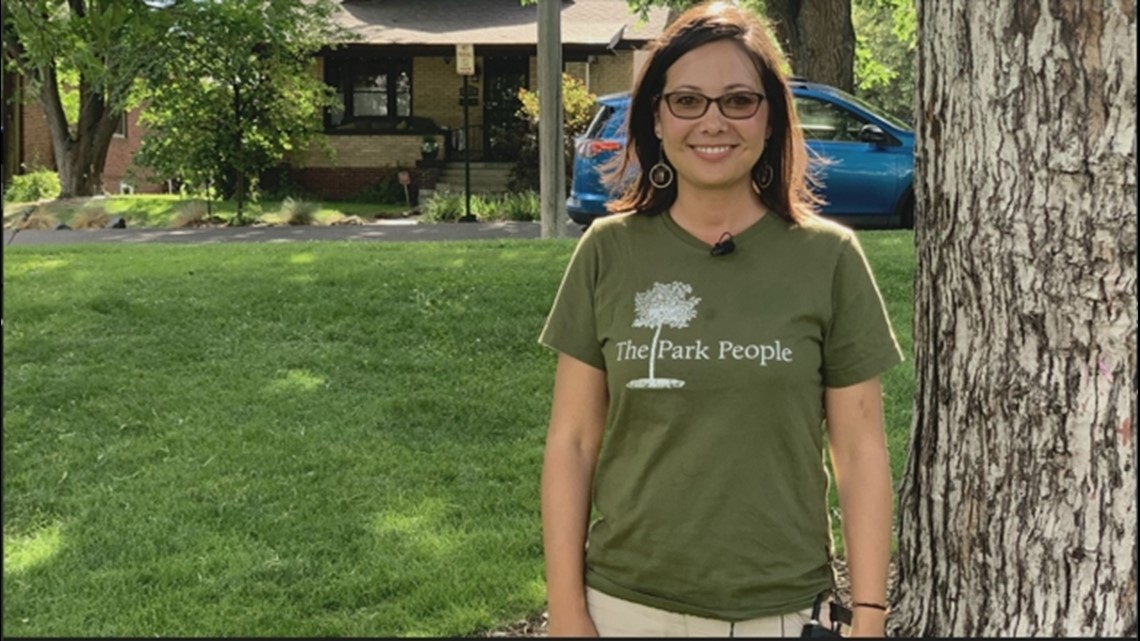DENVER — At a community pool in the Globeville neighborhood, dozens of families filled the water to cool off from the summer heat.
It was a common sight at several spots in the Denver metro Saturday as record-setting heat hit the area.
Across town, Kim Yuan-Farrell said something came to her mind as she stepped outside.
"Every time I go out, step outside and feel what that heat feels like, I can't help but think about our low canopy neighborhoods," she said.
Those low canopy neighborhoods lead to a phenomenon known as the "heat island" effect.
The Environmental Protection Agency says heat islands are mainly in urban areas where buildings, roads and other infrastructure absorb and re-emit the sun’s heat more than natural landscapes such as forests and bodies of water.
This creates the pockets of heat known as heat islands.
"But when you go into a low canopy neighborhood, you can be experiencing temperatures 15, sometimes upwards of 20 degrees hotter than in a well-canopied shaded neighborhood," Yuan-Farrell said.
She's the Executive Director of The Park People, an urban forestry nonprofit that works with communities and volunteers to plant trees and improve parks.


Part of that work tackles the issue of heat islands in underserved communities.
She said most of where the organization does its work is within what's called the "Inverted L."
The phrase, which has been used by the city and county of Denver, describes the neighborhoods that run along Interstate 25 and Interstate 70 in the city, which on a map create an inverted L.
"That's the shape of the neighborhoods that follows the freeways largely and has had a lot of socioeconomic disadvantages and other things in the history of our city's development that lead it to have that low canopy cover," Yuan-Farrell said.
She said some of the neighborhoods in that area have a history of being underserved.
"We see a dynamic where urban heat in those low canopy neighborhoods builds up to such an extreme, and our paved surfaces and buildings absorb and retain that heat. And then even during the nighttime, the cool off isn't dramatic enough," she said. "And so you end up with persistent warm temperatures and people who experience that during the daytime and throughout the night and into the next day. That's really physically dangerous for people who have health vulnerabilities."
She said she believes development can play a role in the making of heat islands.
"With the way we need our city to grow and to densify, we encourage that densification," she said. "However, we don't like seeing big trees that are providing environmental services coming out too much, especially without replacements going in."


There's not much data on how many heat islands exist, but there are some surveys that track them, as well as issues with heat exposure.
A study published last year in Nature Communications found that during the summer of 2017, in nearly all large urban areas, the average non-white person lived in a census tract with higher heat island intensity.
Another study from the EPA found that out of the cities analyzed, Black and African American people are 40% more likely to live in areas with the highest projected increases in extreme temperature-related deaths with 2 degrees Celsius of global warming.
It also found that American Indian people are 37% more likely to live in areas where the ability to work will decrease the most with higher temperatures.
"As cities grow, develop, the amount of paved and built area goes up and often tree canopy and green space is lost," said Brendan Shane, Climate Director of the Trust for Public Land (TPL). "The combined effect is more dangerous heat islands. And when we add the fact that climate change is bringing more heat, it gets worse."
He suggests the U.S. can "green" and cool its communities with trees and green space, lighter surfaces for buildings and roads, and access to splash parks and pools.
For its 2022 ParkScore rankings, the TPL found that 80% of the 100 cities surveyed reported using their parks to address heat risks -- including Denver, Aurora and Colorado Springs.


"It’s important to think citywide for these strategies and also to ensure you are focused on vulnerable communities where the heat is higher and access to reliable air conditioning is lower," Shane said. "But we always recognize that these nature-based efforts to cool communities also bring so many other benefits—better recreation and health and neighbors who know each other and their community."
As for The Park People, Yuan-Farrell said they're working on developing a workforce program in order to possibly pay community members to help with their efforts.
"This summer we are going to be engaging with residents on the ground. We're going to be building some community capacity to do this work, actually paid to a degree," she said. "We definitely encourage anybody in our Denver community to get involved with helping to combat urban heat. It's going to be an increasingly more significant and more serious issue as our climate warms."
In Boulder, the city partnered with NOAA this summer to recruit volunteers to help gather data on heat in the area. That program uses heat sensors mounted on bikes and cars to track heat, in order to create a heat map.
SUGGESTED VIDEOS: Colorado Climate

